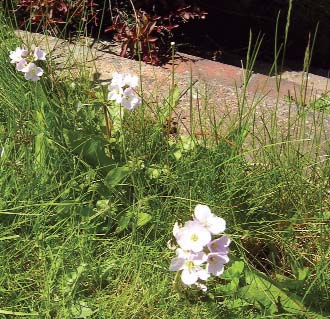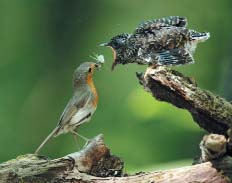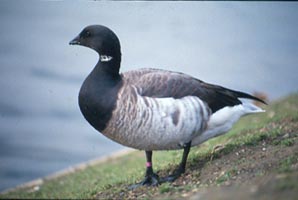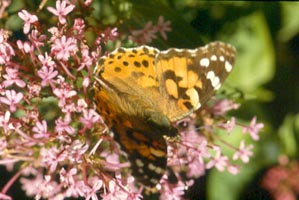| SPRING
WAS IN THE AIR
I’d seen
the female Sparrow hawk over three consecutive weekends perched on different
trees but always in the same small area of woodland and I was certain she
was nesting nearby. When their chicks are hatched they parent bird will often
perch on nearby trees keeping watch, rather then perching on the tree they’re
nesting in and possibly drawing attention to the nest and its contents. A
lot of birds of prey have very basic nests or use old nests of crows but
Sparrow hawks build their own nests with the male initiating the building
by placing a few twigs on a conifer tree then bringing the female to view
the site. He might prospect a few nest sites before he finds one she approves
of and then they’will begin building. For a number of years Sparrow
hawks had nested in a Larch tree with the nest no higher the fifteen feet
up the tree, which itself was only a few feet away from a frequently used
path. Unfortunately that tree was blown over one winter and I hadn’t
seen them nesting in the vicinity for years but this time it looked like
they were back. The fourth weekend after first seeing her my companion and
I stopped to look for her and soon saw her perched on a dead conifer. Sparrow
hawks have one permanent expression, fierce. With big alert yellow eyes and
hooked bill they look like angry killing machines, though very beautiful
and graceful ones. But this bird was emitting soft short calls and we soon
saw why when a male Sparrow hawk, a much smaller bird almost half her size,
flew in through the trees then flew up on to her back. They mated very briefly
before he perched a few feet away. They made low calls to each other and
that’s probably as near to being romantic a Sparrow hawks get. The
following week I was in the wood again. Lots more leaves on the trees and
no sign of the Sparrow hawk but thought I’d have a look with the binoculars
anyway. Almost instantly I saw her, perched on a Larch tree. And then, incredibly,
the male flew in again and was mating with her again almost instantly, this
time they were face on to me. I’d have thought they’d have finished
mating weeks before but maybe it’s a way of strengthening the pair
bonding. Or maybe they’re just a lot more romantic then I thought.
 |
A
few years ago I found a lovely little mauve pink flower growing in the
garden and eventually identified it as Lady’s Smock, a native wild
flower usually found growing in wet or peaty land. How it got in my garden
I’ve no idea. I wouldn’t have thought the conditions in my
garden would have been suitable and although very wild and overgrown in
places it certainly doesn’t resemble a bog. I’d have thought
the soil was too well drained since you only have to dig down a few feet
before hitting solid granite. Maybe the granite actually stops the soil
drying out. Anyhow, I was delighted to have it and was very careful to
avoid Lady’s Smock cutting the charming little plant and gradually
over the years it has spread around the garden and now numbers dozens of
plants. I’ve no doubt I’ve accidentally eliminated a few of
them under the lawnmower since their small leaved stem blends in very subtly
with tufts of long grass but there is still a ever expanding population.
I just heard recently they are a very good food plant for Orange Tip butterflies
which emerge in late spring. Lady’s Smock is also known as the Cuckoo
Flower, not because it parasites other plants but because its flowers emerge
in late April when the male Cuckoo arrives and begins calling. There was
a very reliable |
report
that a Cuckoo had been calling on Killiney Hill one evening in late April
this year. They often start calling as soon as they hit land but if no
female is attracted they’ll move on. A few years ago one spent a
few days calling in the wood on Torca Road and I was very lucky to be able
to see it perched on a Eucalyptus tree.
I, like many volunteers around the country, have been conducting
bird surveys on designated areas of one square kilometre for the last 10
years. The squares are visited twice in the breeding season early in the
morning, once in late spring and then at least 6 weeks after, usually in
early June before the birds stop singing. All birds seen and heard are
recorded as you walk two transect paths. The survey, the CBS or Countryside
Breeding Bird survey, is to record declines or increases in breeding bird
populations and will go on for many years. The squares were picked at random
to cover every possible type of habitat from the middle of towns to lakesides,
bogs and every other type of habitat.
|
My
square is in North Wexford and although a long distance to drive to in
the early hours, it is in a beautiful setting, a farm in a valley with
rolling hillsides, pastureland and woods. Delighted this year to hear a
Cuckoo calling on the farm though it gradually moved away inland and I
didn’t get a glance of it. Cuckoos are in serious decline in the
UK and Ireland and no one knows exactly why although there are a few theories.
Their main host species in Ireland is the Meadow Pipit and although there
has been a decline in their numbers it has been nothing like the Cuckoos
decrease. There is a possibility they might be facing hazards in their
African wintering ground or on their long migration route.
|
There
used be a supermarket manager in Dalkey who told me his father had kept
and fed a young Cuckoo in a cage over the course of a winter since he presumed
it was abandoned by its parents and I’ve heard of other well intentioned
people keeping young cuckoos, thinking they wouldn’t be able to survive
in the wild.
Of course Cuckoos in the wild will never see their parents anyway, they
are probably well on their way back to Africa while their offspring are
still being frantically fed by their ‘foster’ parents. When
fledged and able to fend for themselves they will fly all the way to southern
Africa, alone and just using their inbuilt navigation system to get there.One
of the most memorable ‘birding’ sights I’ve ever been
lucky enough to see was during the heatwave summer of ‘95 when I
was touring around Donegal in beautiful sunshine. I’d stayed a night
in Gweedore in a B&B and in the morning walking down a laneway I saw
a young Cuckoo sitting on a rock in a field being fed by a Meadow Pipit,
a bird perhaps half its size. |
 |
The
dog had sounded her squirrel bark but evidently the squirrel had taken the
most effective action and froze motionless in the pine tree. But we kept
looking and after a few minutes we saw a movement along a branch. At first
I saw pale fur and thought it a Grey but when it moved I saw it was the white
fur of the underside of a Red Squirrel. It moved on to a Sycamore and began
eating the newly opened flowers. I’d seen reds eating the flowers of
Horse Chestnut trees before and the newly opened flower bracts of regenerated
Elm trees are a very substantial part of their diet in spring but hadn’t
seen one on a sycamore before. It moved on to another sycamore, right over
the path and made its way out on to a dead branch. No flowers here, just
leafless twigs but the squirrel started gnawing on the bark and seconds later
a shower of peeled bark was raining down around us. The Grey Squirrel causes
a lot of damage to young trees when it peels off the bark to eat the rising
sap but this branch the red was eating was dead and it might well have been
eating fungus which is another substantial part of its diet. Sap or fungus,
whatever it was eating it was enjoying its meal, totally oblivious to us
and our barking dog a few feet below. A few weeks later, early one morning,
the dog tore ahead and I saw a Red on a tall thin Larch tree. It was quite
a way up but started coming down the trunk which I thought odd until I saw
there was another red squirrel further down the trunk. They were snaking
around the tree chasing each other then went out on higher branches and leaped
on to the next tree. They’re wonderful animals to see, moving through
the tree canopy racing up the trunks and effortlessly leaping from branch
to branch. Compared to the Reds, Greys are much heavier and clumsier leaving
bending boughs in their wake, maybe because they spend more time feeding
on the ground. It was great to see a pair of Red Squirrels together in the
woods on Killiney Hill and they definitely looked like a ‘item’
so, with a bit of luck, they might breed and have a family.
|



